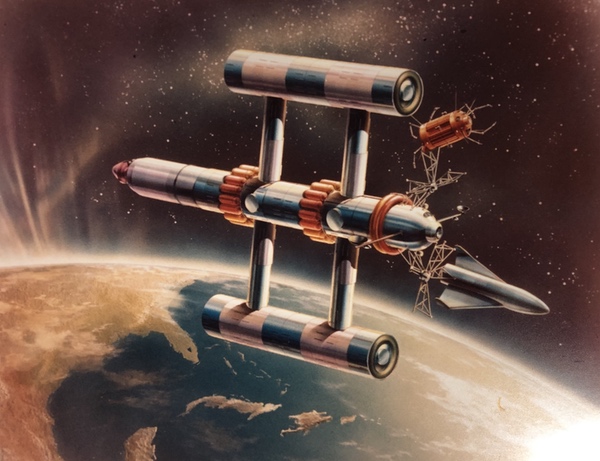The Military Test Space Station (MTSS)by Hans Dolfing
|
| The MTSS deserves more than a footnote in the list of US space station concepts because this study generated quite a diverse but detailed set of zero and artificial-gravity stations for which many basic arguments are still valid. |
One such USAF study, SR 17527, Task Nr 7969, titled the Military Test Space Station (MTSS), with a timeframe between 1959 to 1962, is discussed here based on a two, mostly forgotten sets of documents. [1,2] While basic overviews of the MTSS are mentioned in the literature, recent historical research has uncovered more primary documents to shed light on the interplay of the military and a fledgling civilian NASA to design and build the first space stations including missions and experiments. [3,13,12]
The MTSS deserves more than a footnote in the list of US space station concepts because this study generated quite a diverse but detailed set of zero and artificial-gravity stations for which many basic arguments are still valid. Without history, it is easy to repeat mistakes in the future. To design future space stations, it helps to understand the ingenious and innovative space structures from the 1960s.
The USAF Air Research and Development Command (ARDC) requested the Aeronautical Systems Division (ASD) at Wright-Patterson Air Force Base in September 1959 to study the MTSS. [7] At the time, ARDC was commanded by Gen. Bernard Schriever. [19,21] It was loosely derived from the study SR 181 on a “Strategic Orbital System” and planned as a critical technology development laboratory. [12] Broad guidance was issued but a specific request was to study military experiments in the space station. Request for proposals went out in February 1960 and 12 companies responded. While some sources talk about 125 experiments, a list of 136 experiments was compiled as detailed later. [1,2]
From 12 proposals, five contractors were selected in April 1960 and contracts were awarded in August of the same year. A total of $575,000 was divided among four contractors, with $150,000 each to McDonnell Aircraft Corp., General Electric (GE), and Lockheed plus $125,000 to Martin in Denver. General Dynamics contributed a fifth, unfunded study based on company policy.
There were two study phases of six months each. The “early capability” phase I was concluded in April 1961 and considered pre-1965 space stations. Reports were submitted by July 1961 as confirmed by bibliographic references. [1,7,16-18] Phase II for the “advanced permanent” station was completed by January 1962. Additional funds of $5 million were requested for fiscal year 1963 but not granted, which curtailed the MTSS studies in favor of the Recoverable Orbital Launch System (ROLS) and possibly the March 1962 concept of a Military Orbital Development System (MODS). [6,40,41]
In May 1960, a two-page article by Col. Lowell B. Smith in Aero/Space engineering magazine discussed the MTSS, which shed light on the general goals. [3] In the article, he discussed the space program including the X-15 and Dyna-Soar, and postulates the space station as next logical step for the Air Force. The space station would have two broad and balanced missions with both scientific and military tests, a line of thought that would persist for years. [21] The program should have equal project partners for the civilian and military side. To gain insight in life in space, it should study life science, plant life, and general zero-g life with cosmic radiation. In addition, astronomy with questions on the ionosphere, plus Earth’s magnetic fields and general radio astronomy were mentioned. On the military side, the article included nuclear rockets: the space station would fly high enough such that tests would not contaminate the atmosphere. In addition, guidance, surveillance, and man itself would be tested in space. The initial operation was envisioned for 1970 as follow-on to Mercury and Dyna-Soar programs to develop a national space capability.
It turns out that this Aero/Space engineering magazine from May 1960 is actually a treasure trove for historians as there are at least ten articles on space station concepts from 1960. Some articles were authored by engineers and companies that would also participate in the MTSS. [4,5,20]
It seems no MTSS hardware for launch was ever built. [6,7] However, there are tantalizing hints and pictures by GDA/Convair tagged as MTSS, which show a three-floor mockup plus astronauts. These pictures are from 1961, within the correct time frame, and the space station picture is identical with the GDA/MARS picture in slide 17 of the presentation discussed below. [26-28]
The MTSS presentation by Col. L.B. Smith
Based on these few published details, one might wonder what type of space station was planned for the MTSS? What did it look like visually? A largely forgotten document titled “Presentation on Military Test Station Study SR 17527” by Col. Lowell B. Smith dated December 10, 1963, provides some answers. [1] This is the same colonel who wrote the public 1960 MTSS article discussed above. [3]
The full 58 pages from the National Archives and Records (NARA) cover two studies, the MTSS SR 17527 as well as the Space Logistics Maintenance and Rescue Study (SLOMAR) SR 79814 study. [1] As such, keep in mind that the MTSS was not studied in isolation but in conjunction with logistics, supply, and scheduling issues.
| When did the USAF MTSS personnel first meet these NASA space station engineers; in other words, when did the crossover of space station ideas and concepts start? The best guess is earlier than 1960. |
The MTSS presentation alone consists of 19 slides plus seven pages of typed talking points covering all slides. The slides seem to have been shuffled at some point, which leads to a bit of uncertainty regarding image descriptions. The presentation addresses an outline, objectives, milestones, contractors, and tests.
This briefing and presentation were sent to NASA’s Ames Research Center on December 31, 1963, which hints that NASA wanted to know more about previous USAF work to inform future space station studies. As this presentation was after the end of the MTSS Phase II, it has conclusions for both phase I and II. One of the conclusions states, “The study laid the foundation for the MODS development plan and the present Orbital Space Station study,” which is relevant as MTSS remained unfunded in 1963. [1]
Note that there is only one distribution list of briefed and attending personnel from NASA, DoD, and possibly CIA. The distribution list covers the last two pages and is extensive and requires further study. Names that stand out as “attending” are from NASA HQ E. Schnitzer, and NASA/Manned Spacecraft Center (MSC) R. Burglund (likely, they meant R. Berglund) as well as E.H. Olling. Wernher von Braun at NASA/MFSC was copied but not in the audience.
E.H. Olling proposed the development plan “Project Olympus” space station for NASA/MSC on July 16, 1962, as well as the Multipurpose, Manned Space Station in May 1963. [23,25] R. Berglund worked in 1962 on the “Self erecting Manned Space Laboratories” and E. Schnitzer worked on an inflatable torus for “A Manned Orbital Space Laboratory”. [22,24]
One related question is when the USAF MTSS personnel first met these NASA space station engineers; in other words, when did the crossover of space station ideas and concepts start? The best guess is earlier than 1960, which would explain why MTSS artwork shows similarities with NASA space station artwork a few years later. While speculation, it feels like this December 1963 briefing from the USAF/ARDC had the objective to bring NASA up to speed on the civilian side after the MTSS study.
As evidence, there are letters at NARA from E. Schnitzer at Langley Research Center, who writes on August 18, 196,0 to Maj. Zimmerman at WADD/ARDC based on an ARDC request on May 31, 1960, to share the Langley Research Center effort on space stations including biomedical research. The letters make it clear that ARDC shared their Manned Orbital Laboratories work on May 31 with Langley. At that time, Schnitzer was, of course, already working on the inflatable torus station, which was also shared with ARDC. [31] More on the letters in Figure 7 below as they give a lot of detail on the MTSS experiments.
In the 19-slide presentation, the outline is presented as objective, background, statement of work, phase I results, phase II results, and a summary. The financing was already discussed earlier. The five contractors were McDonnell Aircraft Corp., General Electric (GE/MSD), Lockheed (MSD), Martin (Denver), and General Dynamics/Astronautics (GD/A). Regarding timing, phase I aimed at an early capability pre-1965 while phase II looked at a permanent station post-1965.
In the public literature, a detailed summary of MTSS concept details is missing. Therefore, to start with, a copy of slide 15 “Summary of station characteristics - Phase I” as Table 1.
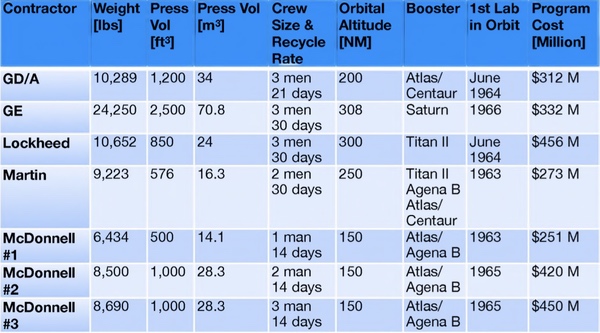 Table 1: MTSS phase 1 summary |
With respect to the volume, these MTTS concepts were all a lot smaller compared to more recent space stations such as the Salyut 6 (90 cubic meters), Skylab (351 cubic meters), Tiangong (122 cubic meters), and the ISS (1,005 cubic meters).
One interesting detail is that several of the phase I concepts, such as from Martin and McDonnell, suggest a smaller crew than requested on slide 8 titled “Study guidelines”. These phase I guidelines specified a minimum one-year lifetime, a three-man crew, an orbital stay time of 14–30 days, and a 1964 capability.
Based on these phase I station characteristics, the conclusions for phase I include that an early capability was feasible. It also included details such as a two-room 750-cubic-foot (21-cubic-meter) volume, a 200-nautical-mile (370-kilometer) orbit inclined at 30 degrees, and an essential artificial-gravity environment. The GE concept was rejected, though, as it did not meet the guidelines for the study. Note that all concepts had a one-up, two-module structure: the station plus re-entry vehicle.
Slide 9 discusses some of the 136 planned experiments that will be discussed in detail. Slide 10 to 14 are images of concept art for phase I stations. Sadly, the images are not labelled, neither front nor back, and the presentation was shuffled at some point in time. The presenter, Col. Smith, notes however there was no image of the GE station.
Slide 10, presented in Figure 2, is the MTSS concept by General Dynamics, the Manned Astronomical Research Station (MARS) station. It is a color version of the identical, degraded image on slide 10. The station concept weighed 10,389 pounds (4,712 kilograms), had 1,200 cubic feet (34 cubic meters) space of pressurized volume, and a crew of three.
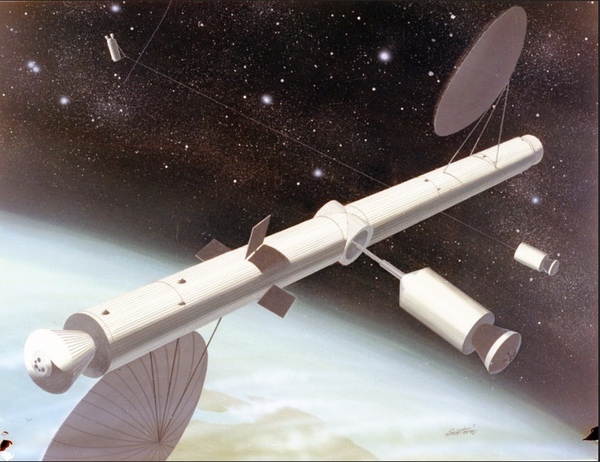 Figure 2: The GD/A “MARS” proposal for MTSS phase I [1,26] |
It had artificial gravity by connecting the empty Centaur Booster and the station by cable and rotating them about their common center of mass.
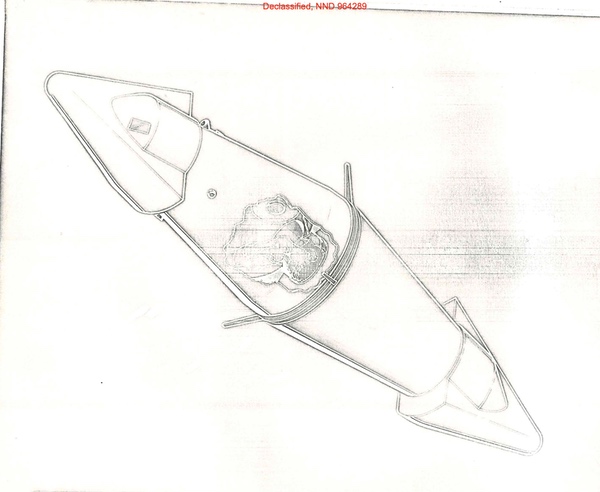 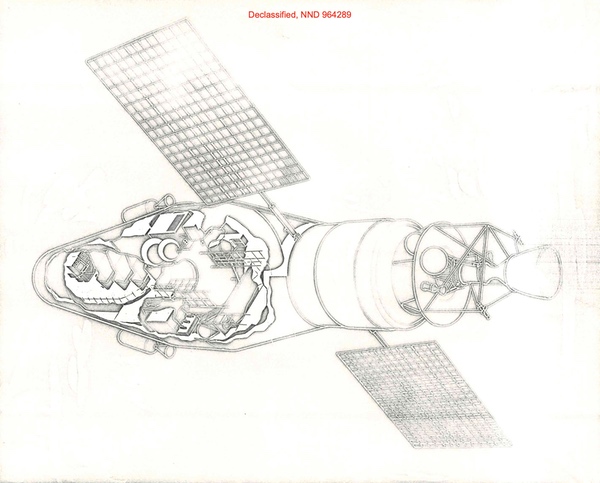 Figure 3: MTSS concepts [1] |
Slides 12 and 13 in Figure 3 cannot be adequately assigned to a Martin or McDonnell phase I design. They do feature the requested crew of three and identifiable reentry vehicles though. It is not even 100% clear whether these were phase I designs but it seems most likely. Martin proposed a 576-cubic-foot (16.3-cubic-meter) pressurized station and McDonnell came up with three different phase I designs.
For the phase II study, slide 17, the advanced permanent space station designs, the contractors considered several modular concepts with fabrication and joining in space. The hand of Krafft Ehricke can be seen in the General Dynamics design, which envisioned a family of four vehicles and six modules that included the ARGO vehicle as a command station, a re-entry vehicle and an emergency living area. The CARGO vehicle was planned as equipment van and laboratory module. The DOCK vehicle provided dock facilities for resupply and crew rotation, and the Manned Resupply Vehicle was designed for crew rotation and support. It would be launched by Atlas/Centaur, similar to slide 10 from the phase I concepts. [1,26,29]
Next, slide 19 and Figure 4 here, this is clearly similar and almost identical to the modular Lockheed station designed by Saunders Kramers. [4,5,30,33] In Figure 4 of his paper “Early engineering designs of space stations”, there is the same space station as in this MTSS presentation, though with an AstroTug instead of the reentry vehicle attached. The station design aimed to alleviate some artificial gravity effects, notably the Coriolis force, which aimed to help the crew compared to small, spinning stations. [5,30] The concept and image is identical to the lead image of the current article titled by NASA as “Early 1960s space station”. [9]
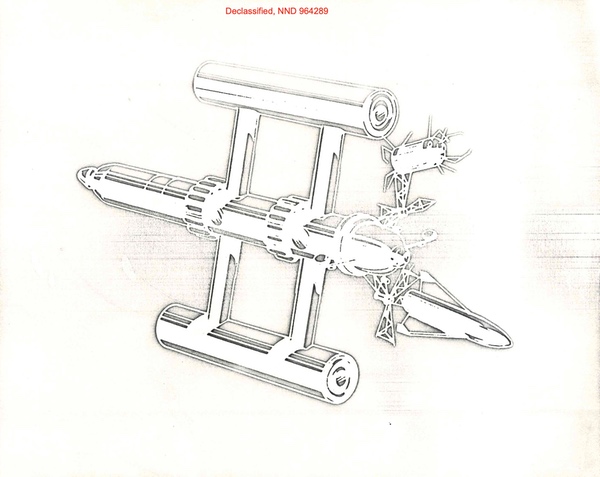 Figure 4: MTSS phase II concept (Lockheed) |
Related is one public report on “space maintenance” that discusses the MTSS, in particular this Lockheed MTSS/Saunders Kramers station, in relation to the SR 79821 “Earth Satellite Weapon System (ESWS)” study as well as the SR 79814 “Space Logistics, Maintenance and Rescue System (SLOMAR) study”. The report mentions “maintenance techniques, assembly techniques for space stations, repair techniques for system components, applicability of terrestrial tools and fasteners, and criteria for remote manipulators. To accomplish these ends, five manned space systems were studied to identify the operating environments and the maintenance, assembly, and repair functions.” [33]
The final slide and image cannot be accurately assigned to a contractor. While the GE, Martin, and McDonnell concepts for phase II were discussed on slide 18, 20, and 21, there is just one more image in the presentation in Figure 5. Most likely, this image is the McDonnell phase II MTSS, as the presentation notes for slide 21 says “the one shown at the bottom”. This image is the only one with two stations, rockets, and modules in top/bottom positions. [1] However, a memo at NARA from NASA Langley to report on a Martin visit on January 26, 1960, says. “The Baltimore concept in its early stages would utilize a single, cylindrical module as the station with Mercury-type vehicle”. [2,31] That would also fit with the Martin MTSS phase I concept discussed earlier on slide 12.
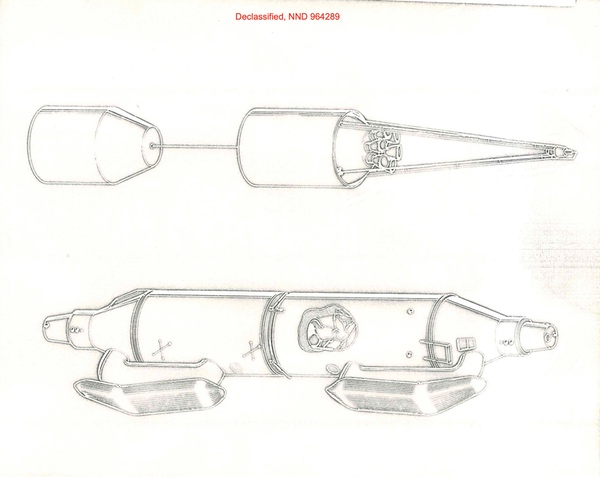 Figure 5: MTSS phase II concept (Unknown) |
With respect to the GE phase II design of the MTSS, Col. Smith discusses on page six of the talking notes, about slide 18 with the GE design: “The four spokes of the station are the supply module of the ferry together with empty booster tankage. This configuration weighing about 120,000 lbs. [54,400 kilograms] with a 5600 cu. ft. [159-cubic-meter] pressurized volume represented the maximum station size. Artificial gravity was to be provided by rotating the spokes about the hub module.” [1] While that does not fit any un-assigned pictures in Figure 3 or 5, or any other presentation images, the description fits surprisingly well with a picture reported in an article from 1963 which is explicitly captioned as “MTSS” and “GE” in Figure 6. [32,41]
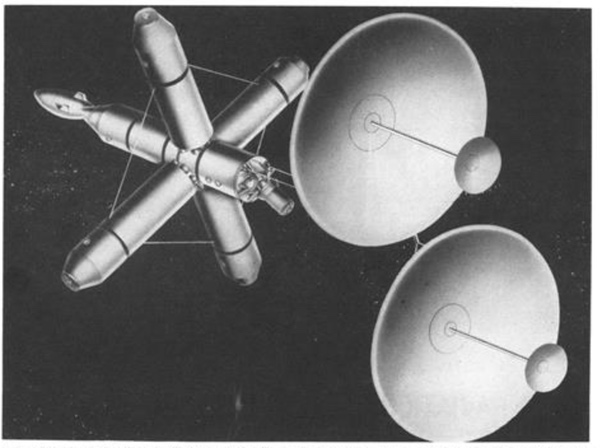 Figure 6: MTTS by General Electric [32] |
Note that the advanced MTSS “phase II” concepts on slide 22 increased the crew sizes from three to sic, with recycle rates for crew from 30 to 60 days, and delivery boosters are now envisioned as Atlas D Centaur, Saturn, S-IV, or Saturn C-1. The first “lab in orbit” date moved to 1965–1968 with program costs of up to $1,364 million for Lockheed.
The phase II conclusions felt that an advanced station in 1970s was feasible including “with rendezvous and tinker toy techniques”. The list of experiments to be discussed was felt to be inadequate to define a definite space configuration. The phase I early capability stations were seen as an essential step towards the more advanced stations.
The presentation concludes with actions that came out of the study. First, an advanced development objective for the Air Force space station was established. Second, two space station studies are named as having received input from the MTSS, the Military Orbital Development System (MODS), which begun in March 1962 and changed into the Orbital Space Station Study (OSS) in July 1963. Finally, that a large space station in the 1970s was perceived to be feasible.
In summary, this presentation gives more details about how many MTSS concepts were studied, what some of them looked like visually, project costs, boosters, and benefits. In addition, the links between the leading civilian space station concepts and people have been clarified, The MTSS did not exist in isolation but in a world where the military and civilian space transport aspect were carefully unraveled such that each could pursue is own goals. Even the logistics of resupply plus ferry equipment was studied.
MTSS science and experiments
NARA in Philadelphia has two boxes of materials relevant to MTSS. They are part of a larger collection of space materials from the early 1960 space stations. [2] The collection includes a lot of materials from NASA’s Langley Research Center (LaRC) in Virginia, where a lot of early US space station work was done. [2,24,35,37]
A list of 136 experiments was planned for the MTSS. [1] In this bundle of materials, a great example is a letter from the Aeronautical Systems Division (ASD), Air Force Systems Command, at Wright-Patterson Air Force Base, Ohio, going to North American Aviation (NAA). The letter in Figure 7 plus its six detailed attachments are dated December 27, 1961. It was sent by the Air Force to a contractor, NAA, addressed to a Mr. E.A. Weber in its Space and Information Systems Division, Downey, California.
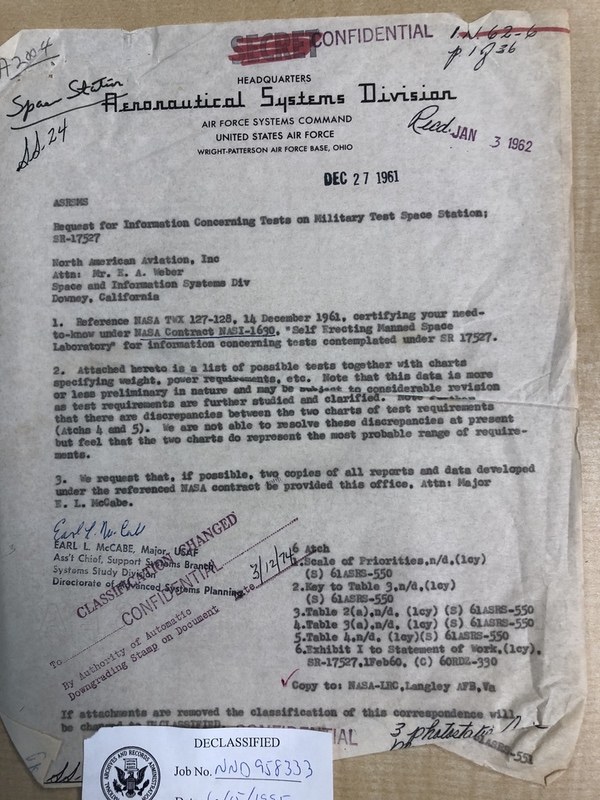 Figure 7: Request for information letter about the MTSS experiments [2] (larger version) |
The attachments address the priorities of all 136 experiments from A to D, plus the requirements, and all known experiment details. The letter mentions that a copy of materials was sent to NASA LaRC, which is probably the reason that this material is still at NARA. This letter is also evidence that NAA knew the MTSS studies were input for its own, later space station studies. [2,34] The letter also describes the package of materials as relevant to the erectable space station study. [36,37] Therefore, the letter clearly demonstrates that the early military space studies informed and overlapped with the later NASA and other studies on space stations.
The first attachment mentioned in the Figure 7 letter is an one page with the “Scale of priorities” from A to D. Tantalizing, it says “as summarized by General Electric,” which points to coordination between ASD and GE as one of the MTSS contractors. The four categories, with five to seven items each, are:
- Operational Systems for MTSS,
- Low Earth Orbit Military Systems,
- Research Development and
- Deep spaceflight.
As a few examples of these categories, there is in (A) an “(A1) Rendezvous and docking” plus an “(A3) Man's capabilities in spacecraft” while in (B) there is “(B1) Detection and tracking of space vehicle” as well as “(B5) Earth attack from space vehicle.” Category (C) is much more general with “(C1) Biological” and “(C2) Physical,” while the category (D) has “(D1) Long-term life testing” and “(D5) Life support and regeneration of supplies.” [2]
| The letter clearly demonstrates that the early military space studies informed and overlapped with the later NASA and other studies on space stations. |
The second attachment is another one-pager with keys to tables and abbreviations in attachments three and four. As an example, it introduces abbreviations for “orientation,” which pertains to the direction certain sensors must be pointed. There is an “E” for Earth, “S” for Sun, “I “for Space, “V” for a combination, and “A” for “no requirement”. Other entries are related to power, to the requested gravity situation (from zero to variable), as well as “man in space” to indicate whether a person needs to operate it outside of the MTSS. [2]
The third attachment is ten pages and describes priorities and details for each of the 136 projected experiments. The experiment numbers are consistent between this attachment and all following attachments including the large “Tests to be conducted at Military test Space Station” discussed below in Figure 8. [2]
The fourth attachment has 11 pages to address the same experiments and their requirements. Each experiment is a one-line entry in the large table. As an example, the experiment number 10 on IR communication with Earth has a one-line entry as 10,E,Z,R,P,D,Ant,60 (Watts), 30 (Pounds), Satellite Comm Effectiveness. This demonstrates that each experiment also had power and weight estimates where available. [2]
Attachment five elaborates these estimated requirements with volume, weight, duration of experiment, manpower and orbit required, and vehicle orientation.
Finally, attachment six is a significant document shown in Figure 8 above, with 164 pages and 136 experiments called “Tests to be conducted at Military test Space Station” as “Exhibit I” to the “Statement of work, SR-17527” dated February 1, 1960. No authors are mentioned, just the designation 6ORDZ-330. Typically, one page describes a single experiment with entries such as title, description, objective, procedure, environment, test equipment, and forms of raw data. Some experiments, though require several pages with details. While it would be fascinating to know who wrote this document, and who provided input, that question will require further study. [2,16-18]
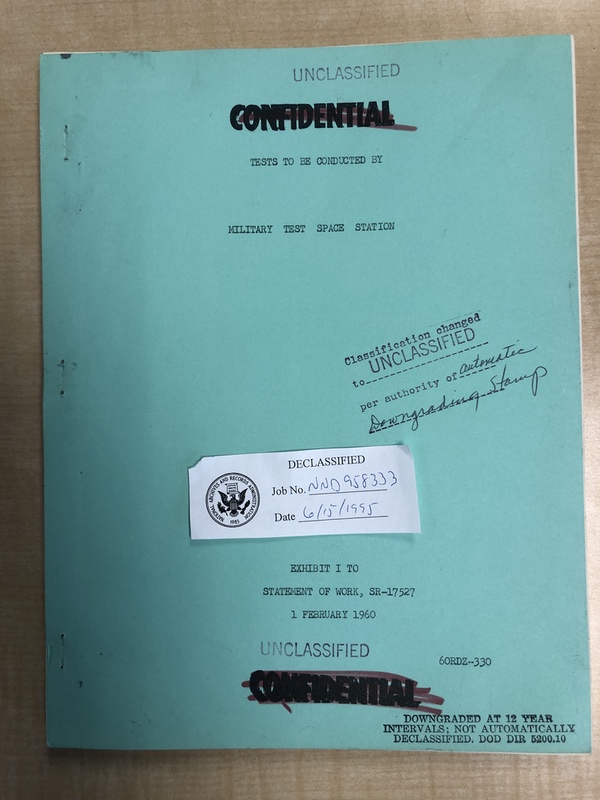 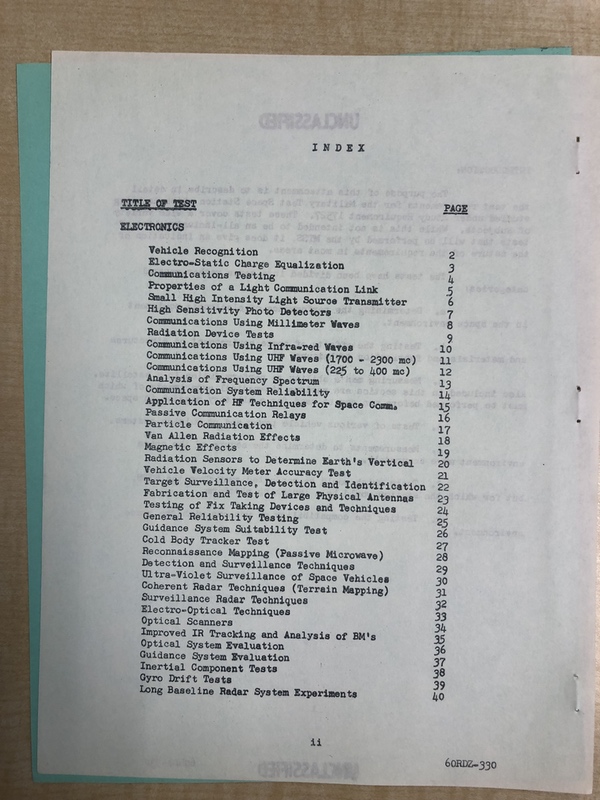 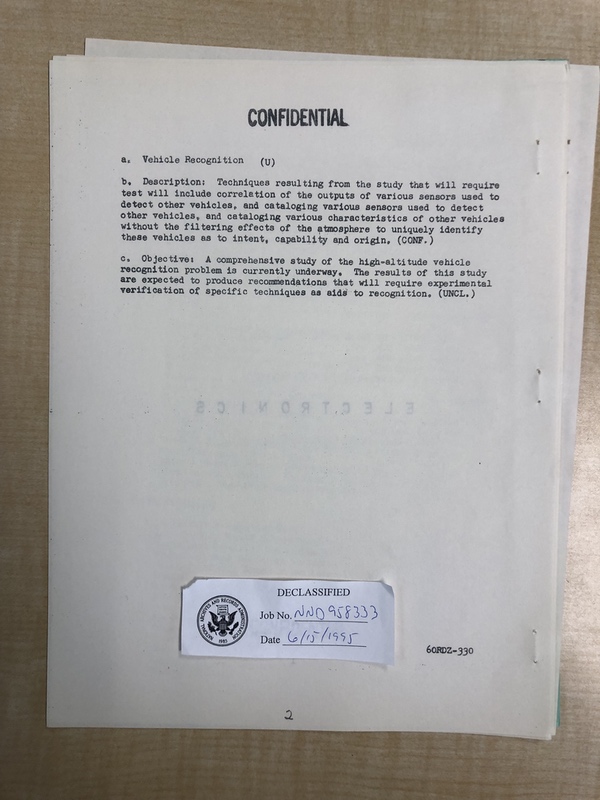 Figure 8: Tests to be conducted at Military test Space Station |
This document says in the introduction on its first page, “The purpose of this attachment is to describe in detail the test requirements for the Military Test Space Station which is being studied under Study Requirement 17527. These tests cover a wide variety of subjects, While this is not intended to be an all-inclusive list of tests that will be performed by the MTSS, it does give an indication of the nature of the requirements in most areas.”
The 136 experiments are allocated to seven categories of tests:
- Electronic equipment in the space environment, 42 pages
- Testing the effects of space environment on structures and materials and fabrication techniques, 31 pages
- Bio-medical and man's ability to perform duties in a satellite, 28 pages
- Vehicle power and propulsion systems, 16 pages
- Space environment, 9 pages
- Launch platform, 5 pages
- Compatibility of weapons with the space environment, 4 pages.
From these categories, the four pages of indexes with experiments (Figure 8 above shows one index page), and the level of detail, it is clear that this was not a quick one-pager “statement of work” but a well-though-out experimental plan that would answer many open questions about work in space. This fits the general picture that, after Sputnik in 1957, the SR “Study Requirements” were meant to catch up, answer, and lead America's way into space.
The document is from a period around 1960, and Project Gemini had not flown yet. Therefore, it is helpful to clarify how much material, in terms of volume and mass, was involved with this list of about 136 experiments. A Gemini capsule would only accommodate very small experiments. For this list of MTSS experiments, sizes vary from small handheld devices to complete reactors. Naturally, every experiment would have a different size such as a handheld compass or free-floating devices analogous to cubesats. Furthermore, there are the power requirements, which presumably needed to be matched with the MTSS space station design. While some experiment descriptions to be discussed mention the use of miniaturized equipment, a sample load of, say, 150 shoeboxes of equipment with a variety of data recording devices would be a large load to bring to a space station, especially in 1960.
| The depth and number of suggested experiments show that the MTSS was not a quick-and-dirty plan but a combination of short- and long-term planning with a pretty big scope. |
To get a better idea of the volumes and mass, the letter in Figure 7 mentions attachment number 4 from the same folder, titled “Estimated requirements for postulated experiments”. This is printed on 12 pages of degraded and hard to read thermal paper. It is a full list of 136 “per experiment” descriptions of expected weight (pounds), volume (cubic feet), power (watts), manpower for the test, duration (days), and what space station orbit and orientation was required. This also gives us a description of the nominal MTSS orbit at 300 nautical miles (556 kilometers), circular, at an inclination of 30 degrees.
The projected list of 136 experiments adds up to a total weight of about 50,000 pounds (22,680 kilograms), a volume of 2,746 cubic feet0 (78 cubic meters) and a power usage of 48 kilowatts. The volume disregards the experiments that would be stored externally, such as a nuclear reactor. The power usage disregards two extreme experiments, which are listed as 30 megawatts for a radiation weapon and 10 kilowatts for vehicle shakedown.
To put the numbers in a modern perspective, very roughly about 10 SpaceX Cargo Dragons would be needed to ferry that weight and volume to the ISS. In terms of power, the ISS produces about 100 kilowatts of solar power on average. For the MTSS, ten flights to ferry 136 experiments would mean about 4.8 kilowatts power available at the MTSS per ride, so 20 times less power on average than the ISS. Those who say “amateurs study tactics, professionals study logistics” have a point.
The shortest-duration experiment was planned for 0.1 hours, which is experiment 74 on page 79 titled a “weightless feeding device”. The longest running experiments were scheduled to run up to one or two years and included “propellant storability device” as experiment 101 on page 109 plus the “guidance system evaluation” as experiment 36 on page 37. This tells us that the final MTSS was planned as a longer-term space station for long-running experiments, which is a good match with the “phase II MTSS” discussed earlier. Questions and experiments such as the “propellant storage” are relevant even today and are almost a look-ahead towards current R&D on propellant depots.
The bulkiest experiments were for external storage at the MTSS and were presumably solar and nuclear reactors, large antennas, and crew escape systems. The heaviest experiments are projected at about 4,000 to 5,000 pounds (1,800 to 2,300 kilograms), which include the radiation weapon and vehicle shakedown. Some communication devices are just 0.3 pounds (0.14 kilograms), though.
The experiments requiring most manpower used five to six people and were complicated military experiments such as experiment 133, the radiation weapon. Most experiments required just one person for supervision. Note that the phase II MTSS concepts discussed earlier had a maximum crew size of six astronauts, which matches this experiment document well.
Finally, what really stands out? One example is the experiment on solar energy generation as experiment number 107 on page 115 titled “solar-mechanical closed loop Rankine cycle power generation system (15kw size)”. Its weight is projected as 811 pounds (368 kilograms) and its name as “Sunflower I”; see Figure 9. This type and name of solar power generation shows up regularly in 1960s NASA studies as well as in Von Braun's early space station concepts. Two attachments contradict each other on the power generation as one says “15 KW” and the other “3 KW” where the latter is closer to the literature. [37,38]
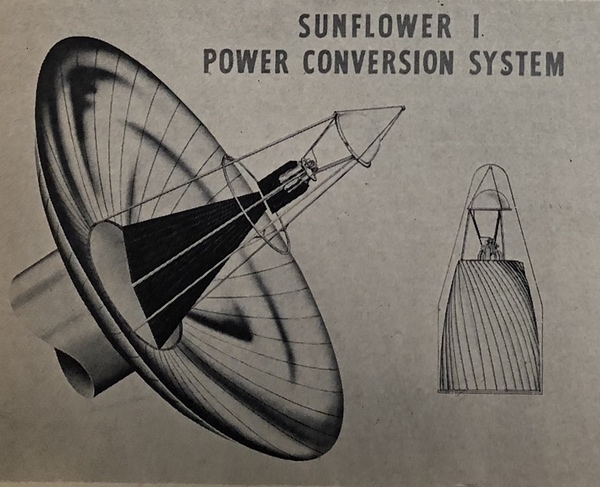 Figure 9: Sunflower solar power [37] |
In 1960, it was not clear whether solar or nuclear power in space was more appropriate or practical. Therefore, there is page 114 with a test number 125 “Nuclear reactors” for comparison with the Sunflower. Sadly, except for a weight of 2,000 pounds (910 kilograms), no other reactor specifics, such as power generation, are discussed.
On biomedical and life sciences, there are experiments similar to what has been tested at the ISS. For example, experiment number 96 on page 101, “Human Performance During Long-Term Space Flight conditions” and 97, “Insect Metamorphosis in Space”. There is also an experiment 98, “Baker's Yeast Growth and Fermentation in Space”.
On propulsion, experiment number 101 on page 109 explains an experiment on “Propellant Storability Test” which sounds like the “depot” testing today. Note that you would not do such a test if you were designing a space station with a short lifetime. They were really looking ahead.
On the military side of the experiments, there are obvious experiments such as number 136 “Nuclear weapons” on page 153 and “Munition testing” as experiment 134 on page 151. The “Nuclear weapons” experiment describes several pages of testing of warheads, initiators, electrical and mechanical components, and everything in space, all to determine scaling laws and figure out what could be stored and how long in space. This obviously relates to contemporary questions on hosting nuclear missiles in space which would require long-term exposure to space.
Next, there is “Launch testing of space to Earth missiles”, as experiment 127 on page 143, which is possibly related to the SR 181 study titled “Strategic orbital System” conducted at the same time. [11] The description includes a phrase “Equipment would consist, of varying configuration (ballistic, high drag, winged, lifting body, etc.) of Earth to Earth missiles with associated alignment, guidance and retro-rocket equipment. Missile and equipment weight range would be approximately 1000-5000 lbs,”; a pretty wide range of equipment testing.
Furthermore, there is a “Radiation weapon” testing. In particular, experiment 133 on page 150 with a note “Radiation weapon devices (project 5237 )” drawing 5,000 watts of power. That particular project numbered 5237 is later known to be about tests of Laser devices. [39] As Lasers were invented only in 1960, it seems that the military was looking ahead and plan for tests in space in the 1970s when the MTSS would be fully operational.
| The MTSS did not exist in isolation but in a world where the military and civilian space transport aspects were carefully being put on separate tracks such that each could pursue is own goals. |
This is followed with experiment 136 on page 152, titled “Radiation weapons trajectory investigations,” which investigated a “Twenty-foot diameter ion radiator focused on 2-foot diameter target at various distance from 100 feet to miles. Power supply to radiation 30 MW at 106 volts.”. That sounds like a particle beam of sorts. It is unclear where they were going to find the required power of 30 megawatts to drive the experiment, though.
The MTSS was supposed to test not only these offensive weapons but also defensive ones. An example is experiment 128 on page 144, titled “Defense using ECM,” which includes the description, “The objective of this test is to determine the capability of a space platform to protect itself from attacking ground launched anti-satellite weapon systems by means of electronic countermeasures.”. In other words, the designers were well aware that a space station could be attacked by an adversary and then some defense via decoys and radiation would be necessary.
Conclusion
The depth and number of suggested experiments show that the MTSS was not a quick-and-dirty plan but a combination of short- and long-term planning with a pretty big scope. Some serious thinking went into this space station with two or even three phases. The total weight of experiments also shows that it was a substantial plan. To learn more, additional analysis of phase I and phase II documents will be necessary when available. [16-18]
For now, it is very evident from the discussed documents that MTSS plans and designs influenced later NASA space station concepts via shared documents, meetings, and people. In particular, the letter in Figure 7 shows that Schnitzer got the MTSS experiment list while he worked on the Inflatable Space Station at LaRC.
The study and contractor concepts definitely informed the later military space station projects such as MODS, MOL, and OSS, as well at the NASA civilian proposals such as MORL. [7,40] Similar space science experiments continue to this day.
Based on the list of 136 MTSS experiments, it is clear that most experiments were civilian oriented and not military. In fact, the balance is almost 90-10 and not 50-50 as suggested by Col. Smith. [3] This could provide another clue why the MTSS funding dried up: NASA was better suited to pursue a civilian space station. The fact that many space technologies were dual-use also shows up in that 1960s Aero/Space Engineer magazine issue where some of the publishing companies with civilian space station articles also participated in MTSS studies. [3,4] It seems likely that the MTSS funding dried up due to political reasons and not technical.
Though the military was ready to go to space based on several years of SR studies, X-15 and Dyna-Soar, the political winds seem to have directed most space-related activities to NASA and the civilian side. In addition, with the advent of Apollo and the Lunar Orbital Rendezvous approach, a space station was seen an unnecessary step to go to the Moon at that time and it simply fell by the wayside.
The documents have added to our knowledge what the MTSS concepts looked like, how many were planned, the phasing, construction, costs and science. The links between the early US space station concepts and people have been clarified. The MTSS did not exist in isolation but in a world where the military and civilian space transport aspects were carefully being put on separate tracks such that each could pursue is own goals.
Endnotes
[1], RG 255.4.1, NACA Ames Aeronautical Laboratory and NASA Ames Research Center, Series 24, Box 3, Central Files - research correspondence, 1943-1965, “Presentation on MTSS SR 17527 by Col. Lowell B. Smith”, 10 Dec 1963, 19 pages, National Archives and Records Administration (NARA), Pacific Region (San Francisco), San Bruno, California.
[2] RG 255, NACA Langley Memorial Aeronautical Laboratory and NASA Langley Research Center Records, A200-4 Manned Space Stations, Series II: Subject Correspondence Files, 1918-1978, Box 421, 422, Sep. 1963 - Nov. 1964, National Archives and Records Administration (NARA), Philadelphia.
[3] Col. Lowell B. Smith, USAF, Space System Office, WADD, ARDC, “The Military Test Space Station”, page 18-19, Aero/Space Engineering (Manned Space Station Issue), May 1960
[4] Saunders B. Kramer, Richard A. Byers (Lockheed Aircraft Corporation), “A modular concept for a multi-manned space station”, page 30-31, Aero/Space Engineering (Manned Space Station Issue), May 1960
[5] Saunders B. Kramer, Richard A. Byers, “A modular concept for a multi-manned space station”, in “Proceedings of the Manned Space Stations Symposium”, pp 36-73, April 20-22, 1960 located at NASA History Division, RG-11, Box 18467.
[6] C. Berger, “The Air Force in Space. Fiscal Year 1962”, USAF Historical Division Liaison Office, ADA 606606, pp 38-42, 1966
[7] “The DORIAN files revealed : A compendium of the NRO's Manned Orbiting Laboratory documents”, edited by James D. Outzen, Ph.D., incl. Carl Berger’s - “A History of the Manned Orbiting Laboratory Program Office” Aug. 2015
[8] “SR-181 Strategic orbital System”, AD-337 659L 3-4-2 DIV. 18A, NTRS 19660089145, volume i final report, 1961
[9] “Space station early 1960s”, NASA History Division, RG-11, Boxes 9088 and 9090,
[10] Sunflower power conversion system quarterly report, mar. - may 1963 ( Sunflower 3 kW mercury Rankine power conversion system), NTRS 19650010819
[11] Dwayne A. Day, “Take off and nuke the site from orbit (it’s the only way to be sure…)” , 2007
[12] “Tough Tommy's Space Force - General Thomas S. Power and the Air Force Space Program”, by Major Brent D. Ziarnick, AD 1030453, 2016
[13] “Rendezvous and Orbital Docking: A Bibliography”, J. F. Price, A. K. Dunlap, Research Bibliography No. 47, Report No. 9990-6385-KU-000, April 1963,
[14] Wernher von Braun, Collier's articles on conquest of space (1952-1954)
[15] Roger D. Launius, Space Stations - Base camps to the stars, ISBN 1-56852-716-0, 2003
[16] General Dynamics/Astronautics (GD/A), San Diego, Calif., Contr. AF 33(600)-42457, Rept. no. AE 61-0570, ASD TR 61-208, Dated: 15 Jul 1961
- SR-17527, “MILITARY TEST SPACE STATION. VOLUME I. SUMMARY (U)”, AD 328 351L, vol. 1, 75 pages.
- SR-17527, “MILITARY TEST SPACE STATION. VOLUME II, PART I, PRE-I965 SPACE STATION (u)”, AD 328 352L, vol. 2, part 1, 166 pages.
- SR-17527, “MILITARY TEST SPACE STATION. VOLUME II, PART I, PRE-I965 SPACE STATION (U)”, AD 328 353L, vol. 2, part 2.
- SR-17527, “MILITARY TEST SPACE STATION. VOLUME III. ADVANCED SPACE STATIONS (U)”, AD 328 354L, vol. 3, illus. tbl. refs.
[17] Lockheed Aircraft Corp., Sunnyvale, Calif. by S. B. Kramer, Contr. AF 33(600)-41944, Rept. no. IMSD-895091, ASD TR 61-21, Dated: 1 Jul 1961
- SR-17527, “POST-1965 VEHICLE MILITARY TEST SPACE STATION (U)”, AD 328 338L, vol. 1, illus., tbl., 37 refs.
[18] Martin Co., Denver, Colo., by R. Hale, Contr. AF 33(600)-42456, Rept. no. M-0361-61-87, ASD TR 61-211, ASD CR 61-14, Dated: Jul 1961.
- SR-17527, “MTSS PHASE II (GAMMA) VEHICLE DESIGN. VOLUME I, (u)”, AD 328 358L, vol. 1, illus., tbl.
- SR-17527, “MTSS TEST MISSIONS. VOLUME II, (u)”, AD 328 359L, vol. 2, 178 pp., illus., tbl.
[19] Gen. Bernhard Schriever.
[20] M. Stoiko, G.G. Kayten (AFIAS), J.W. Dorsey (The Martin Company), “Manned Scientific Orbital Laboratory (MSOL)”, p26-27, Aero/Space Engineering (Manned Space Station Issue), May 1960
[21] Gen. B. Schriever (AFSC), “The Military Contribution to space exploration” in “Proceedings of the National Meeting on Manned Space Flight “, pp 13-14, St. Louis, Apr. 20 - May 2, 1962
[22] R. Berglund, “Self erecting manned space laboratory” in “Proceedings of the National Meeting on Manned Space Flight “, pp 144-149, St. Louis, Apr. 20 - May 2, 1962
[23] E. Olling, “Project Olympus: Proposed Space Station Program”, S-140-92, 32 pages, 16 Jul 1962 at NASA History Division, RG-11, Box 18467.
[24] E. Schnitzer, “A manned orbital laboratory” in “NASA Conference on Thermal radiation problems in space technology”, NASA Langley Research center, p 44-47, NTRS 20150017663, Sept 1960, US patent US3144219 from 11 Aug 1964
[25] C.W. Matthews, E.H. Olling (NASA/MSC), “A Multipurpose, Manned, Orbital Space Station (MOSS)” AIAA and Aerospace Medical Association Manned Space Laboratory Conference, Los Angeles, May 1963.
[26] PictionID: 53813473 - Catalog:14_031290 - Title:GD/Astronautics Art Details: MTSS/Mars-ARGO-Cargo Date: 06/20/1961 - Filename:14_031290.tif - - Images from the Convair/General Dynamics Astronautics Atlas Negative Collection.
[27] PictionID:45176466 - Catalog:14_016953 - Title:MTSS/MARS Details: MTSS/MARS Mock Up with Space Suited Man Date: 03/20/1961 - Filename:14_016953.TIF - Image from the Convair/General Dynamics Astronautics Atlas Negative Collection.
[28] PictionID:53757235 - Catalog:14_031523 - Title:GD/Astronautics Details: MTSS Command Module; Close Up of Flight Commander-Mock Up Date: 06/15/1961 - Filename:14_031523.tif - Images from the Convair/General Dynamics Astronautics Atlas Negative Collection.
[29] PictionID:53813497 - Catalog:14_031292 - Title:GD/Astronautics Art Details: ARGO Space Station in Orbit Date: 09/08/1961 - Filename:14_031292.tif - Images from the Convair/General Dynamics Astronautics Atlas Negative Collection.
[30] Saunders B. Kramer, “Early engineering designs of space stations in the United States: A Memoir”, Journal of the British Interplanetary Society (JBIS), Vol. 46, pp. 163-172, 1993.
[31] Memo from E. Schnitzer to L. Loftin, August 18th 1960, RG 255, NACA Langley Memorial Aeronautical Laboratory and NASA Langley Research Center Records, A200-4 Manned Space Stations, Series II: Subject Correspondence Files, 1918-1978, Box 422, part 2 of 2, Sep. 1963 - Nov. 1964, National Archives and Records Administration (NARA), Philadelphia.
[32] “USAF Gives Space Station Top Priority”, Aviation Week & Space Technology, pp 214-227, July 22, 1963
[33] “Study of space maintenance techniques”, Technical Documentary report No. ASD-TDR-63-931, Project 8170, Task No. 817008, AF 33(657)-7838, DTIC AD 0406776,May 1963
[34] “Extended-Mission Apollo Study, Final report”, North American Aviation (NAA/ASD), contract for NASA NAS9-1963, SID 63-1370-12, Vol 12, 24 Nov 1963
[35] Carter, J.W. and Bogema, B.L., “Inflatable Manned Orbital Vehicles”, in “Proceedings of the Manned Space Stations Symposium”, April 20-22, 1960
[36] “Self-Deploying Space Station”, Final Report, NTRS 19640001819, NAS1-1630, 1962
[37] J.R. Hansen, “Spaceflight revolution NASA Langley Research Center From Sputnik to Apollo”, NASA SP-4308, N95-27685, page 277, 1995.
[38] “TAPCO Group gets NASA Award For Sunflower Solar Power Unit”, Aviation Week, pp 38, April 25, 1960
[39] “Department of Defense Appropriations for 1970”, Hearings before a subcommittee of the committee on Appropriations House of Representatives , 91th Congress, First Session, Part4, June 3rd, 1969.
[40] Butz, Jr, J.S., “The Case for an American Manned Space Station.”, Air Force Magazine, pp 31-36, July 1963.
[41] D.J. Shayler, R. Godwin, Outpost in Orbit, ISBN 9781-989044-03-2, 2018
Note: we are now moderating comments. There will be a delay in posting comments and no guarantee that all submitted comments will be posted.
